Nursing: Case Study Assignment
VerifiedAdded on 2023/01/16
|8
|2385
|1
AI Summary
This case study focuses on a patient recovering from open mesh inguinal hernia repair surgery. It explores the patient's history, symptoms, and the holistic, legal, and ethical approaches used by the nurse in providing care. The case study also discusses the importance of follow-up and proper treatment for hernias.
Contribute Materials
Your contribution can guide someone’s learning journey. Share your
documents today.
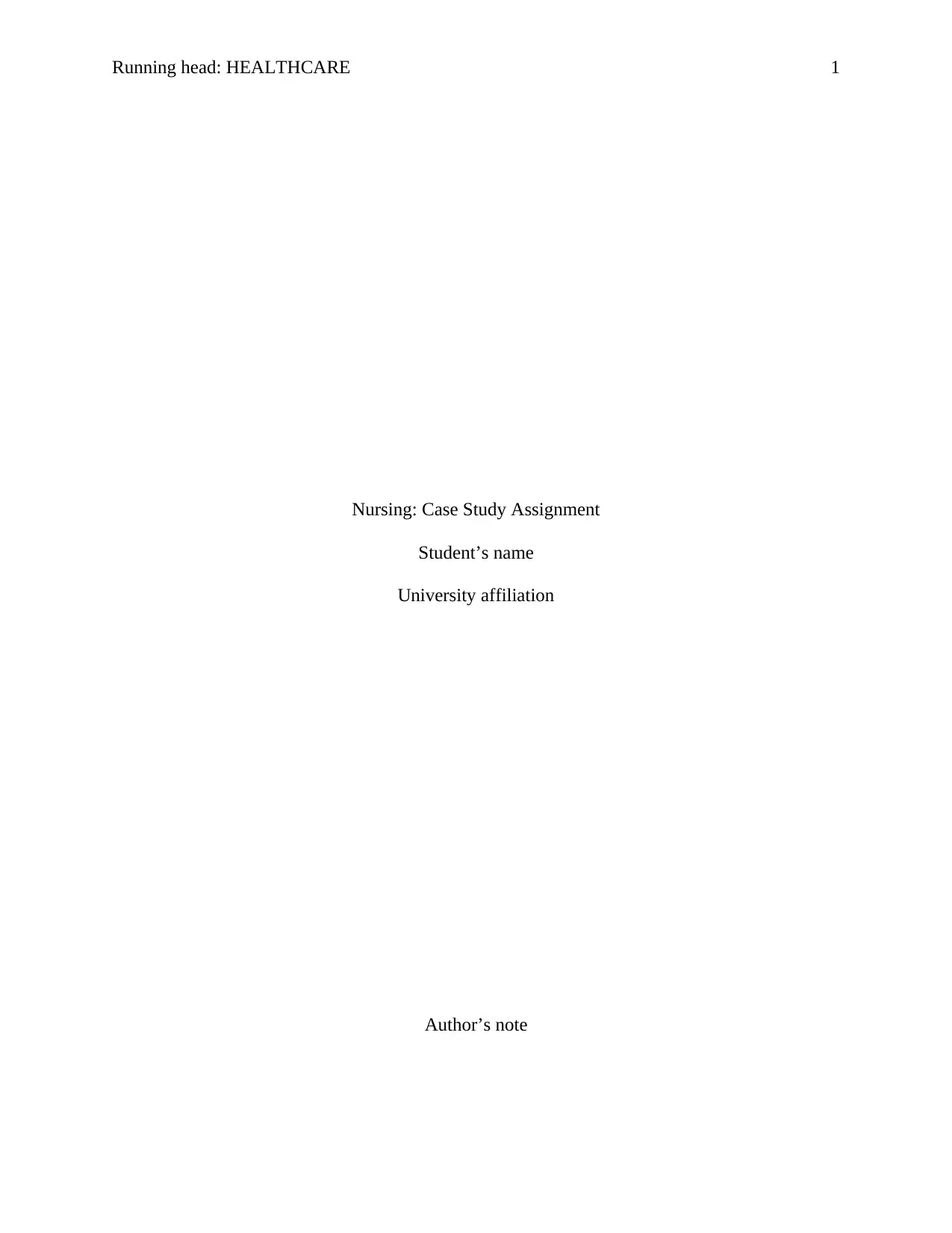
Running head: HEALTHCARE 1
Nursing: Case Study Assignment
Student’s name
University affiliation
Author’s note
Nursing: Case Study Assignment
Student’s name
University affiliation
Author’s note
Secure Best Marks with AI Grader
Need help grading? Try our AI Grader for instant feedback on your assignments.
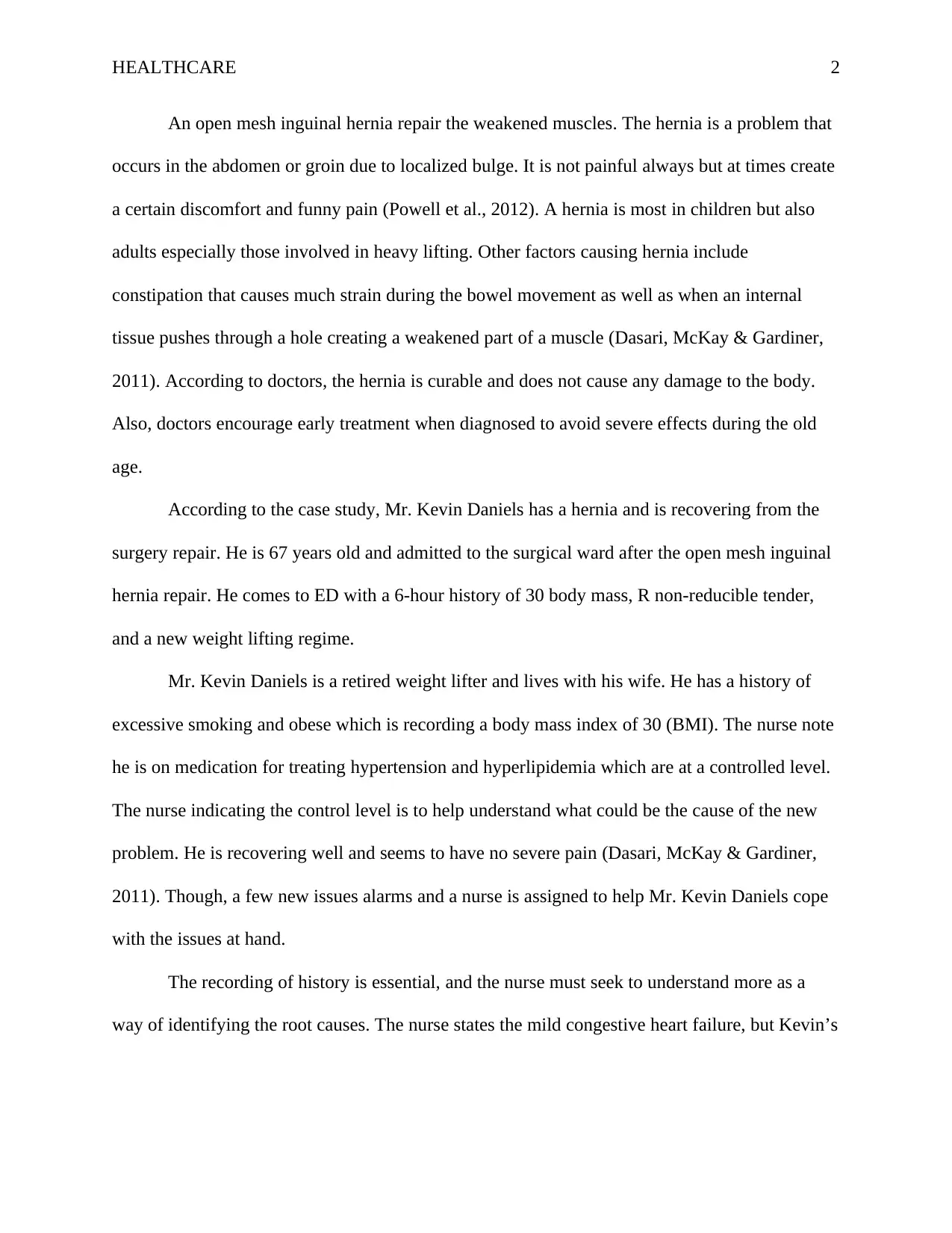
HEALTHCARE 2
An open mesh inguinal hernia repair the weakened muscles. The hernia is a problem that
occurs in the abdomen or groin due to localized bulge. It is not painful always but at times create
a certain discomfort and funny pain (Powell et al., 2012). A hernia is most in children but also
adults especially those involved in heavy lifting. Other factors causing hernia include
constipation that causes much strain during the bowel movement as well as when an internal
tissue pushes through a hole creating a weakened part of a muscle (Dasari, McKay & Gardiner,
2011). According to doctors, the hernia is curable and does not cause any damage to the body.
Also, doctors encourage early treatment when diagnosed to avoid severe effects during the old
age.
According to the case study, Mr. Kevin Daniels has a hernia and is recovering from the
surgery repair. He is 67 years old and admitted to the surgical ward after the open mesh inguinal
hernia repair. He comes to ED with a 6-hour history of 30 body mass, R non-reducible tender,
and a new weight lifting regime.
Mr. Kevin Daniels is a retired weight lifter and lives with his wife. He has a history of
excessive smoking and obese which is recording a body mass index of 30 (BMI). The nurse note
he is on medication for treating hypertension and hyperlipidemia which are at a controlled level.
The nurse indicating the control level is to help understand what could be the cause of the new
problem. He is recovering well and seems to have no severe pain (Dasari, McKay & Gardiner,
2011). Though, a few new issues alarms and a nurse is assigned to help Mr. Kevin Daniels cope
with the issues at hand.
The recording of history is essential, and the nurse must seek to understand more as a
way of identifying the root causes. The nurse states the mild congestive heart failure, but Kevin’s
An open mesh inguinal hernia repair the weakened muscles. The hernia is a problem that
occurs in the abdomen or groin due to localized bulge. It is not painful always but at times create
a certain discomfort and funny pain (Powell et al., 2012). A hernia is most in children but also
adults especially those involved in heavy lifting. Other factors causing hernia include
constipation that causes much strain during the bowel movement as well as when an internal
tissue pushes through a hole creating a weakened part of a muscle (Dasari, McKay & Gardiner,
2011). According to doctors, the hernia is curable and does not cause any damage to the body.
Also, doctors encourage early treatment when diagnosed to avoid severe effects during the old
age.
According to the case study, Mr. Kevin Daniels has a hernia and is recovering from the
surgery repair. He is 67 years old and admitted to the surgical ward after the open mesh inguinal
hernia repair. He comes to ED with a 6-hour history of 30 body mass, R non-reducible tender,
and a new weight lifting regime.
Mr. Kevin Daniels is a retired weight lifter and lives with his wife. He has a history of
excessive smoking and obese which is recording a body mass index of 30 (BMI). The nurse note
he is on medication for treating hypertension and hyperlipidemia which are at a controlled level.
The nurse indicating the control level is to help understand what could be the cause of the new
problem. He is recovering well and seems to have no severe pain (Dasari, McKay & Gardiner,
2011). Though, a few new issues alarms and a nurse is assigned to help Mr. Kevin Daniels cope
with the issues at hand.
The recording of history is essential, and the nurse must seek to understand more as a
way of identifying the root causes. The nurse states the mild congestive heart failure, but Kevin’s
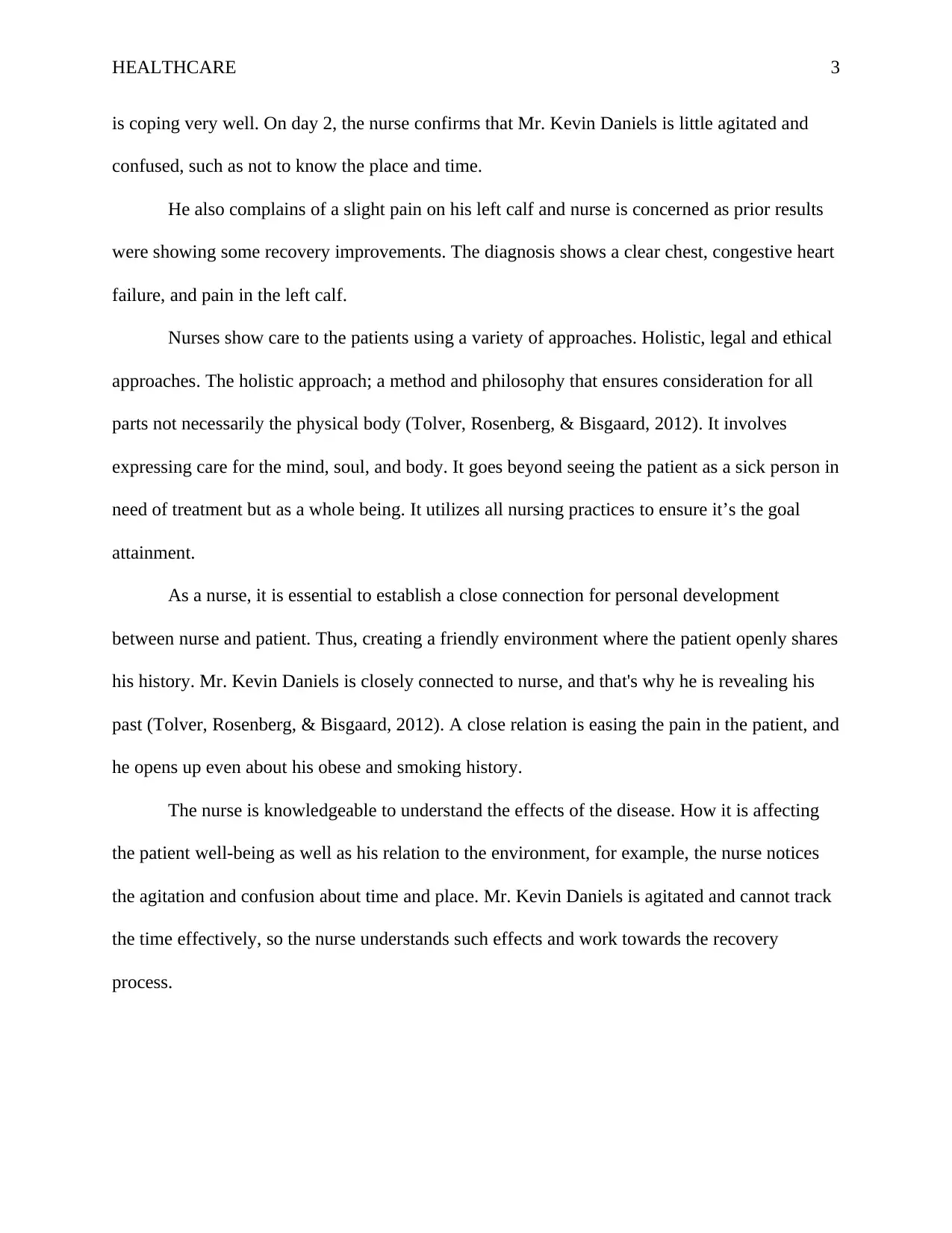
HEALTHCARE 3
is coping very well. On day 2, the nurse confirms that Mr. Kevin Daniels is little agitated and
confused, such as not to know the place and time.
He also complains of a slight pain on his left calf and nurse is concerned as prior results
were showing some recovery improvements. The diagnosis shows a clear chest, congestive heart
failure, and pain in the left calf.
Nurses show care to the patients using a variety of approaches. Holistic, legal and ethical
approaches. The holistic approach; a method and philosophy that ensures consideration for all
parts not necessarily the physical body (Tolver, Rosenberg, & Bisgaard, 2012). It involves
expressing care for the mind, soul, and body. It goes beyond seeing the patient as a sick person in
need of treatment but as a whole being. It utilizes all nursing practices to ensure it’s the goal
attainment.
As a nurse, it is essential to establish a close connection for personal development
between nurse and patient. Thus, creating a friendly environment where the patient openly shares
his history. Mr. Kevin Daniels is closely connected to nurse, and that's why he is revealing his
past (Tolver, Rosenberg, & Bisgaard, 2012). A close relation is easing the pain in the patient, and
he opens up even about his obese and smoking history.
The nurse is knowledgeable to understand the effects of the disease. How it is affecting
the patient well-being as well as his relation to the environment, for example, the nurse notices
the agitation and confusion about time and place. Mr. Kevin Daniels is agitated and cannot track
the time effectively, so the nurse understands such effects and work towards the recovery
process.
is coping very well. On day 2, the nurse confirms that Mr. Kevin Daniels is little agitated and
confused, such as not to know the place and time.
He also complains of a slight pain on his left calf and nurse is concerned as prior results
were showing some recovery improvements. The diagnosis shows a clear chest, congestive heart
failure, and pain in the left calf.
Nurses show care to the patients using a variety of approaches. Holistic, legal and ethical
approaches. The holistic approach; a method and philosophy that ensures consideration for all
parts not necessarily the physical body (Tolver, Rosenberg, & Bisgaard, 2012). It involves
expressing care for the mind, soul, and body. It goes beyond seeing the patient as a sick person in
need of treatment but as a whole being. It utilizes all nursing practices to ensure it’s the goal
attainment.
As a nurse, it is essential to establish a close connection for personal development
between nurse and patient. Thus, creating a friendly environment where the patient openly shares
his history. Mr. Kevin Daniels is closely connected to nurse, and that's why he is revealing his
past (Tolver, Rosenberg, & Bisgaard, 2012). A close relation is easing the pain in the patient, and
he opens up even about his obese and smoking history.
The nurse is knowledgeable to understand the effects of the disease. How it is affecting
the patient well-being as well as his relation to the environment, for example, the nurse notices
the agitation and confusion about time and place. Mr. Kevin Daniels is agitated and cannot track
the time effectively, so the nurse understands such effects and work towards the recovery
process.
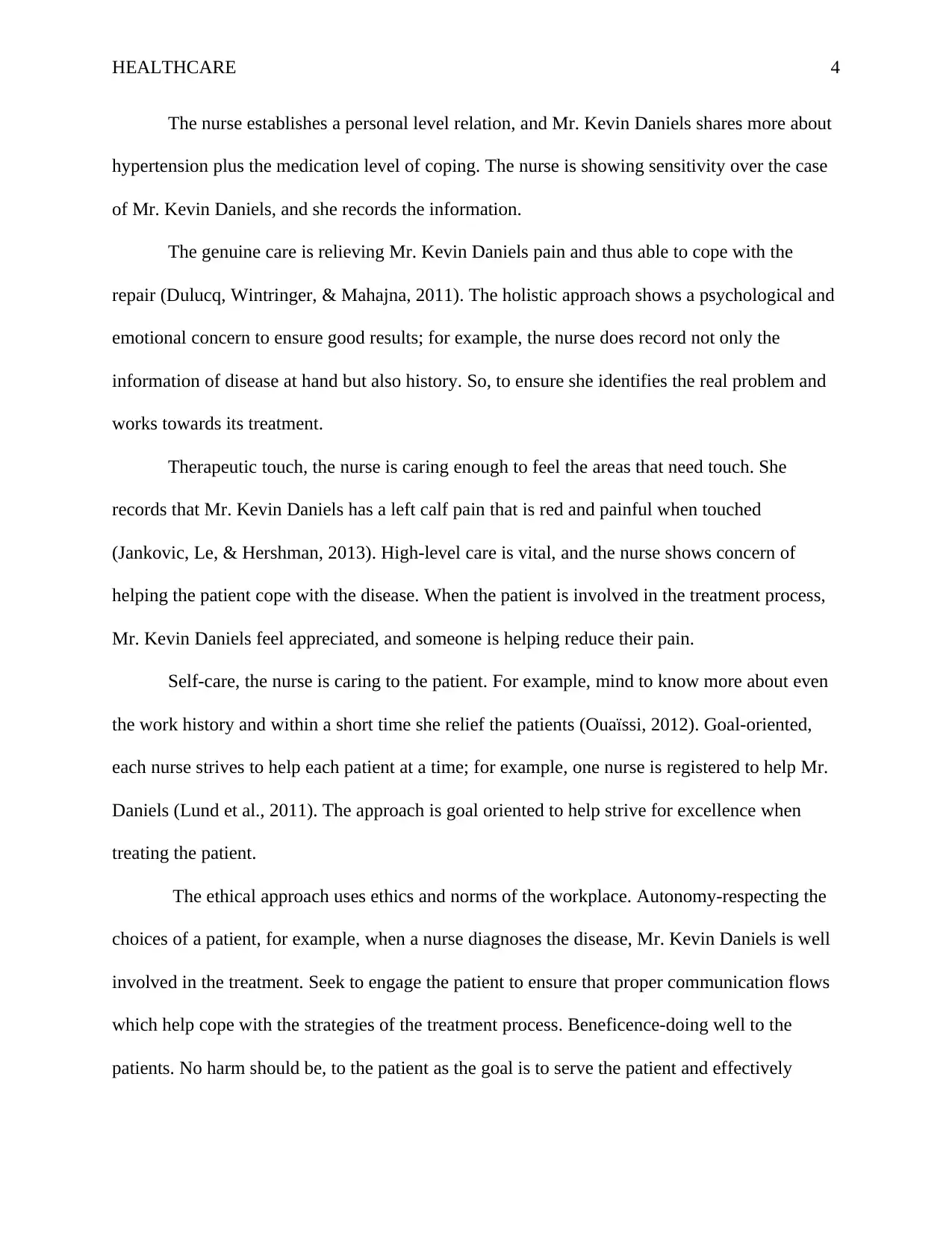
HEALTHCARE 4
The nurse establishes a personal level relation, and Mr. Kevin Daniels shares more about
hypertension plus the medication level of coping. The nurse is showing sensitivity over the case
of Mr. Kevin Daniels, and she records the information.
The genuine care is relieving Mr. Kevin Daniels pain and thus able to cope with the
repair (Dulucq, Wintringer, & Mahajna, 2011). The holistic approach shows a psychological and
emotional concern to ensure good results; for example, the nurse does record not only the
information of disease at hand but also history. So, to ensure she identifies the real problem and
works towards its treatment.
Therapeutic touch, the nurse is caring enough to feel the areas that need touch. She
records that Mr. Kevin Daniels has a left calf pain that is red and painful when touched
(Jankovic, Le, & Hershman, 2013). High-level care is vital, and the nurse shows concern of
helping the patient cope with the disease. When the patient is involved in the treatment process,
Mr. Kevin Daniels feel appreciated, and someone is helping reduce their pain.
Self-care, the nurse is caring to the patient. For example, mind to know more about even
the work history and within a short time she relief the patients (Ouaïssi, 2012). Goal-oriented,
each nurse strives to help each patient at a time; for example, one nurse is registered to help Mr.
Daniels (Lund et al., 2011). The approach is goal oriented to help strive for excellence when
treating the patient.
The ethical approach uses ethics and norms of the workplace. Autonomy-respecting the
choices of a patient, for example, when a nurse diagnoses the disease, Mr. Kevin Daniels is well
involved in the treatment. Seek to engage the patient to ensure that proper communication flows
which help cope with the strategies of the treatment process. Beneficence-doing well to the
patients. No harm should be, to the patient as the goal is to serve the patient and effectively
The nurse establishes a personal level relation, and Mr. Kevin Daniels shares more about
hypertension plus the medication level of coping. The nurse is showing sensitivity over the case
of Mr. Kevin Daniels, and she records the information.
The genuine care is relieving Mr. Kevin Daniels pain and thus able to cope with the
repair (Dulucq, Wintringer, & Mahajna, 2011). The holistic approach shows a psychological and
emotional concern to ensure good results; for example, the nurse does record not only the
information of disease at hand but also history. So, to ensure she identifies the real problem and
works towards its treatment.
Therapeutic touch, the nurse is caring enough to feel the areas that need touch. She
records that Mr. Kevin Daniels has a left calf pain that is red and painful when touched
(Jankovic, Le, & Hershman, 2013). High-level care is vital, and the nurse shows concern of
helping the patient cope with the disease. When the patient is involved in the treatment process,
Mr. Kevin Daniels feel appreciated, and someone is helping reduce their pain.
Self-care, the nurse is caring to the patient. For example, mind to know more about even
the work history and within a short time she relief the patients (Ouaïssi, 2012). Goal-oriented,
each nurse strives to help each patient at a time; for example, one nurse is registered to help Mr.
Daniels (Lund et al., 2011). The approach is goal oriented to help strive for excellence when
treating the patient.
The ethical approach uses ethics and norms of the workplace. Autonomy-respecting the
choices of a patient, for example, when a nurse diagnoses the disease, Mr. Kevin Daniels is well
involved in the treatment. Seek to engage the patient to ensure that proper communication flows
which help cope with the strategies of the treatment process. Beneficence-doing well to the
patients. No harm should be, to the patient as the goal is to serve the patient and effectively
Secure Best Marks with AI Grader
Need help grading? Try our AI Grader for instant feedback on your assignments.
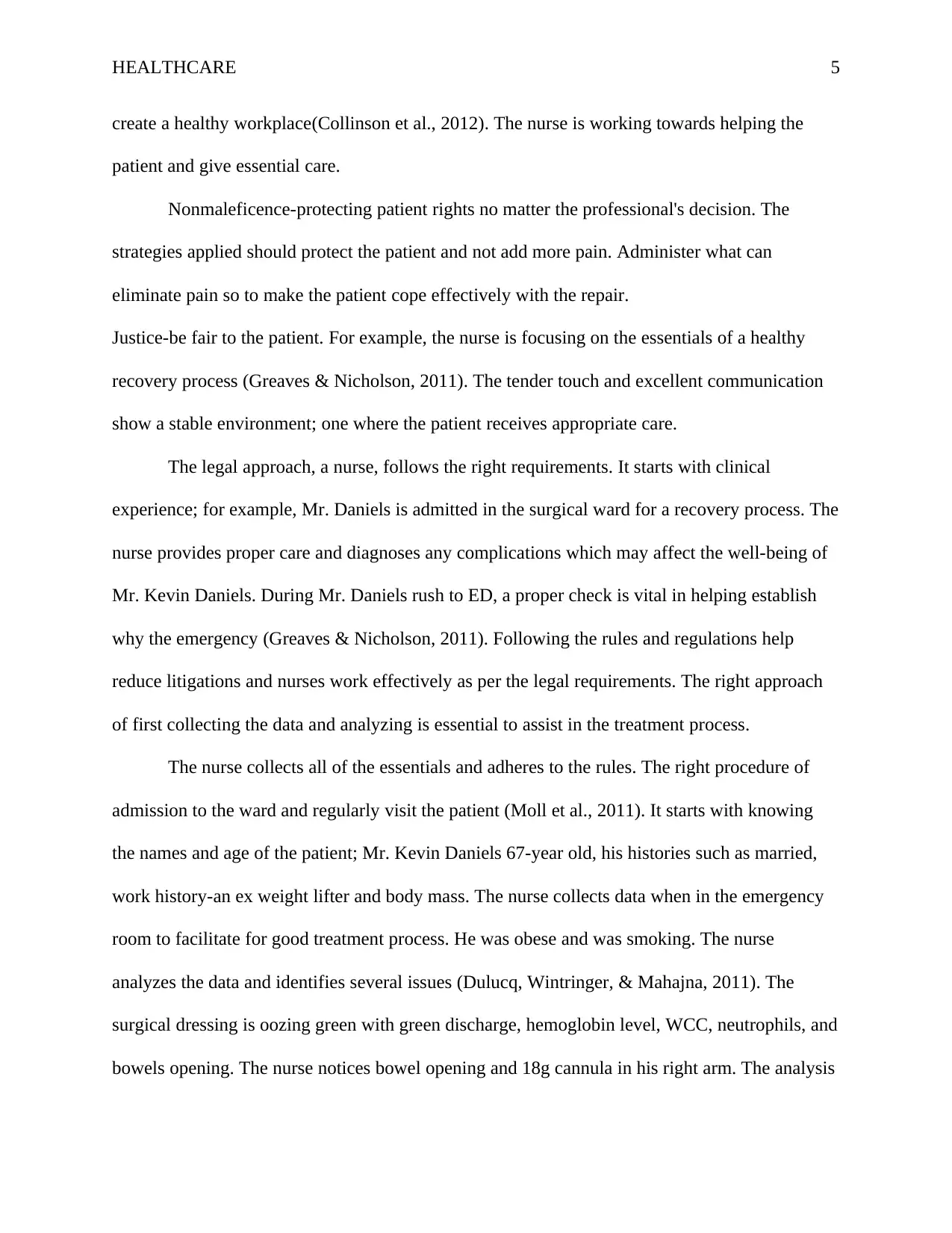
HEALTHCARE 5
create a healthy workplace(Collinson et al., 2012). The nurse is working towards helping the
patient and give essential care.
Nonmaleficence-protecting patient rights no matter the professional's decision. The
strategies applied should protect the patient and not add more pain. Administer what can
eliminate pain so to make the patient cope effectively with the repair.
Justice-be fair to the patient. For example, the nurse is focusing on the essentials of a healthy
recovery process (Greaves & Nicholson, 2011). The tender touch and excellent communication
show a stable environment; one where the patient receives appropriate care.
The legal approach, a nurse, follows the right requirements. It starts with clinical
experience; for example, Mr. Daniels is admitted in the surgical ward for a recovery process. The
nurse provides proper care and diagnoses any complications which may affect the well-being of
Mr. Kevin Daniels. During Mr. Daniels rush to ED, a proper check is vital in helping establish
why the emergency (Greaves & Nicholson, 2011). Following the rules and regulations help
reduce litigations and nurses work effectively as per the legal requirements. The right approach
of first collecting the data and analyzing is essential to assist in the treatment process.
The nurse collects all of the essentials and adheres to the rules. The right procedure of
admission to the ward and regularly visit the patient (Moll et al., 2011). It starts with knowing
the names and age of the patient; Mr. Kevin Daniels 67-year old, his histories such as married,
work history-an ex weight lifter and body mass. The nurse collects data when in the emergency
room to facilitate for good treatment process. He was obese and was smoking. The nurse
analyzes the data and identifies several issues (Dulucq, Wintringer, & Mahajna, 2011). The
surgical dressing is oozing green with green discharge, hemoglobin level, WCC, neutrophils, and
bowels opening. The nurse notices bowel opening and 18g cannula in his right arm. The analysis
create a healthy workplace(Collinson et al., 2012). The nurse is working towards helping the
patient and give essential care.
Nonmaleficence-protecting patient rights no matter the professional's decision. The
strategies applied should protect the patient and not add more pain. Administer what can
eliminate pain so to make the patient cope effectively with the repair.
Justice-be fair to the patient. For example, the nurse is focusing on the essentials of a healthy
recovery process (Greaves & Nicholson, 2011). The tender touch and excellent communication
show a stable environment; one where the patient receives appropriate care.
The legal approach, a nurse, follows the right requirements. It starts with clinical
experience; for example, Mr. Daniels is admitted in the surgical ward for a recovery process. The
nurse provides proper care and diagnoses any complications which may affect the well-being of
Mr. Kevin Daniels. During Mr. Daniels rush to ED, a proper check is vital in helping establish
why the emergency (Greaves & Nicholson, 2011). Following the rules and regulations help
reduce litigations and nurses work effectively as per the legal requirements. The right approach
of first collecting the data and analyzing is essential to assist in the treatment process.
The nurse collects all of the essentials and adheres to the rules. The right procedure of
admission to the ward and regularly visit the patient (Moll et al., 2011). It starts with knowing
the names and age of the patient; Mr. Kevin Daniels 67-year old, his histories such as married,
work history-an ex weight lifter and body mass. The nurse collects data when in the emergency
room to facilitate for good treatment process. He was obese and was smoking. The nurse
analyzes the data and identifies several issues (Dulucq, Wintringer, & Mahajna, 2011). The
surgical dressing is oozing green with green discharge, hemoglobin level, WCC, neutrophils, and
bowels opening. The nurse notices bowel opening and 18g cannula in his right arm. The analysis

HEALTHCARE 6
concludes that Mr. Daniel is agitated and confused which may be as a result of being restless. A
hernia does cause discomfort and funny pains which can result in other several body parts (Gupta
et al., 2011). The surgeries are performed to repair by running a long and straightforward
incision in the groin.
Nurse perceived quality of care throughout the case study quality care is evident. The
nurse is utilizing evidence-based data in the care provision. The analyzing of data and
presentation by the nurse demonstrates quality care such as Mr. Daniels getting involved in the
treatment process. More exceptional nurse autonomy-the respect for patient’s decision is
essential and create room for co-operation between nurse and patient (Ahmed, Al-Shaikh, &
Akhtar, 2012). The proper personal relationship-the nurse should show more excellent care and
sensitivity when dealing with the patients. She should make the patient embrace their situation,
and together they work towards its treatment.
The Incisional hernia is frequent after colorectal carcinoma resection. It helps in clinical
examination of hernia to ensure the open surgery completely heal the disease. It depends on the
follow-up after the surgery, for the hernia to completely disappear (Gupta et al., 2011). When a
hernia is not well treated, it may re-occur and cannot go without treatment. It's essential for
patients to visit health centers in case of any symptoms such as pain in the abdomen.
A hernia is a simple disease which requires open surgery depending on the type. The
surgery helps in stitching together the wall and muscles which were separated. Seek medical
advice as appropriate care is vital.
concludes that Mr. Daniel is agitated and confused which may be as a result of being restless. A
hernia does cause discomfort and funny pains which can result in other several body parts (Gupta
et al., 2011). The surgeries are performed to repair by running a long and straightforward
incision in the groin.
Nurse perceived quality of care throughout the case study quality care is evident. The
nurse is utilizing evidence-based data in the care provision. The analyzing of data and
presentation by the nurse demonstrates quality care such as Mr. Daniels getting involved in the
treatment process. More exceptional nurse autonomy-the respect for patient’s decision is
essential and create room for co-operation between nurse and patient (Ahmed, Al-Shaikh, &
Akhtar, 2012). The proper personal relationship-the nurse should show more excellent care and
sensitivity when dealing with the patients. She should make the patient embrace their situation,
and together they work towards its treatment.
The Incisional hernia is frequent after colorectal carcinoma resection. It helps in clinical
examination of hernia to ensure the open surgery completely heal the disease. It depends on the
follow-up after the surgery, for the hernia to completely disappear (Gupta et al., 2011). When a
hernia is not well treated, it may re-occur and cannot go without treatment. It's essential for
patients to visit health centers in case of any symptoms such as pain in the abdomen.
A hernia is a simple disease which requires open surgery depending on the type. The
surgery helps in stitching together the wall and muscles which were separated. Seek medical
advice as appropriate care is vital.
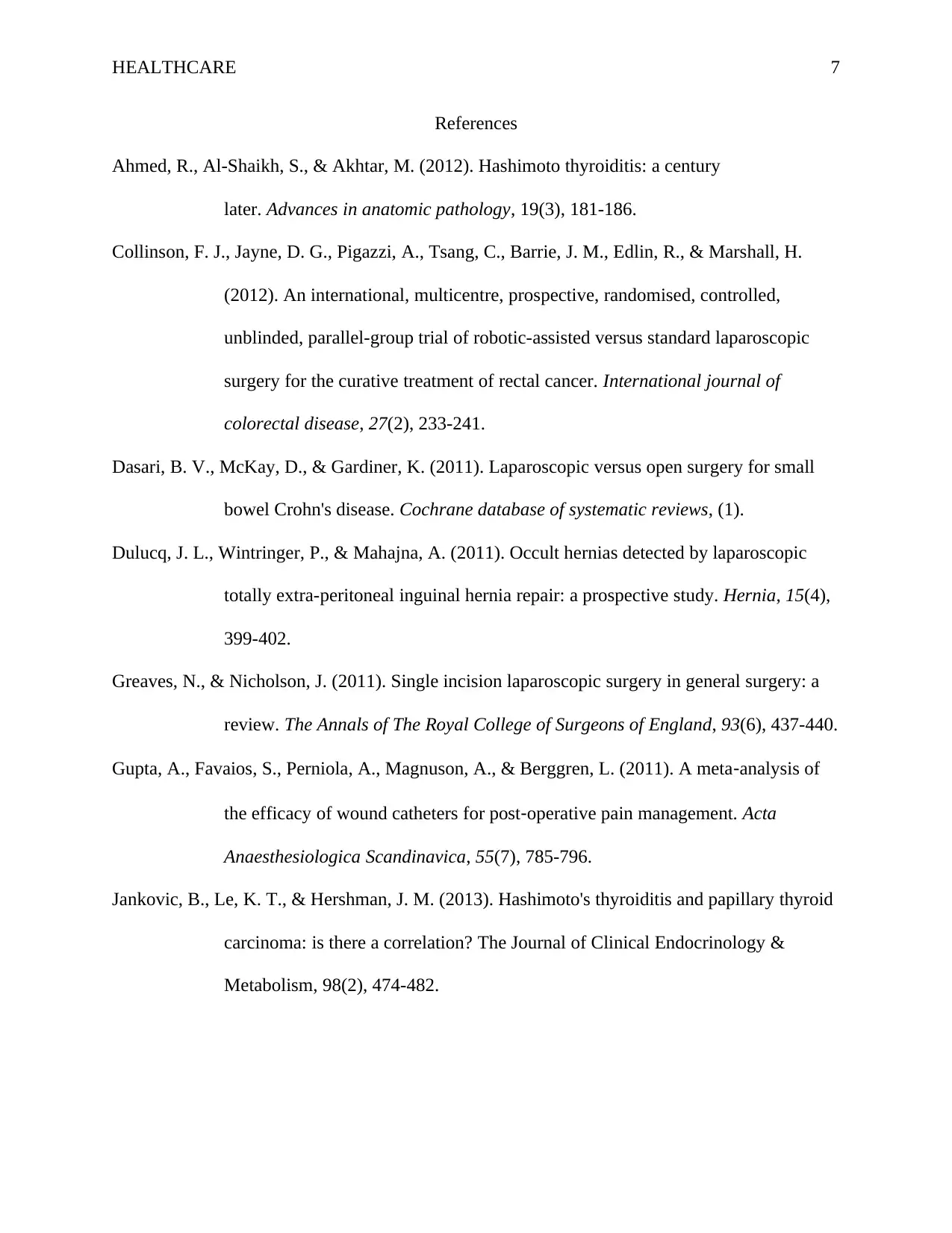
HEALTHCARE 7
References
Ahmed, R., Al-Shaikh, S., & Akhtar, M. (2012). Hashimoto thyroiditis: a century
later. Advances in anatomic pathology, 19(3), 181-186.
Collinson, F. J., Jayne, D. G., Pigazzi, A., Tsang, C., Barrie, J. M., Edlin, R., & Marshall, H.
(2012). An international, multicentre, prospective, randomised, controlled,
unblinded, parallel-group trial of robotic-assisted versus standard laparoscopic
surgery for the curative treatment of rectal cancer. International journal of
colorectal disease, 27(2), 233-241.
Dasari, B. V., McKay, D., & Gardiner, K. (2011). Laparoscopic versus open surgery for small
bowel Crohn's disease. Cochrane database of systematic reviews, (1).
Dulucq, J. L., Wintringer, P., & Mahajna, A. (2011). Occult hernias detected by laparoscopic
totally extra-peritoneal inguinal hernia repair: a prospective study. Hernia, 15(4),
399-402.
Greaves, N., & Nicholson, J. (2011). Single incision laparoscopic surgery in general surgery: a
review. The Annals of The Royal College of Surgeons of England, 93(6), 437-440.
Gupta, A., Favaios, S., Perniola, A., Magnuson, A., & Berggren, L. (2011). A meta‐analysis of
the efficacy of wound catheters for post‐operative pain management. Acta
Anaesthesiologica Scandinavica, 55(7), 785-796.
Jankovic, B., Le, K. T., & Hershman, J. M. (2013). Hashimoto's thyroiditis and papillary thyroid
carcinoma: is there a correlation? The Journal of Clinical Endocrinology &
Metabolism, 98(2), 474-482.
References
Ahmed, R., Al-Shaikh, S., & Akhtar, M. (2012). Hashimoto thyroiditis: a century
later. Advances in anatomic pathology, 19(3), 181-186.
Collinson, F. J., Jayne, D. G., Pigazzi, A., Tsang, C., Barrie, J. M., Edlin, R., & Marshall, H.
(2012). An international, multicentre, prospective, randomised, controlled,
unblinded, parallel-group trial of robotic-assisted versus standard laparoscopic
surgery for the curative treatment of rectal cancer. International journal of
colorectal disease, 27(2), 233-241.
Dasari, B. V., McKay, D., & Gardiner, K. (2011). Laparoscopic versus open surgery for small
bowel Crohn's disease. Cochrane database of systematic reviews, (1).
Dulucq, J. L., Wintringer, P., & Mahajna, A. (2011). Occult hernias detected by laparoscopic
totally extra-peritoneal inguinal hernia repair: a prospective study. Hernia, 15(4),
399-402.
Greaves, N., & Nicholson, J. (2011). Single incision laparoscopic surgery in general surgery: a
review. The Annals of The Royal College of Surgeons of England, 93(6), 437-440.
Gupta, A., Favaios, S., Perniola, A., Magnuson, A., & Berggren, L. (2011). A meta‐analysis of
the efficacy of wound catheters for post‐operative pain management. Acta
Anaesthesiologica Scandinavica, 55(7), 785-796.
Jankovic, B., Le, K. T., & Hershman, J. M. (2013). Hashimoto's thyroiditis and papillary thyroid
carcinoma: is there a correlation? The Journal of Clinical Endocrinology &
Metabolism, 98(2), 474-482.
Paraphrase This Document
Need a fresh take? Get an instant paraphrase of this document with our AI Paraphraser
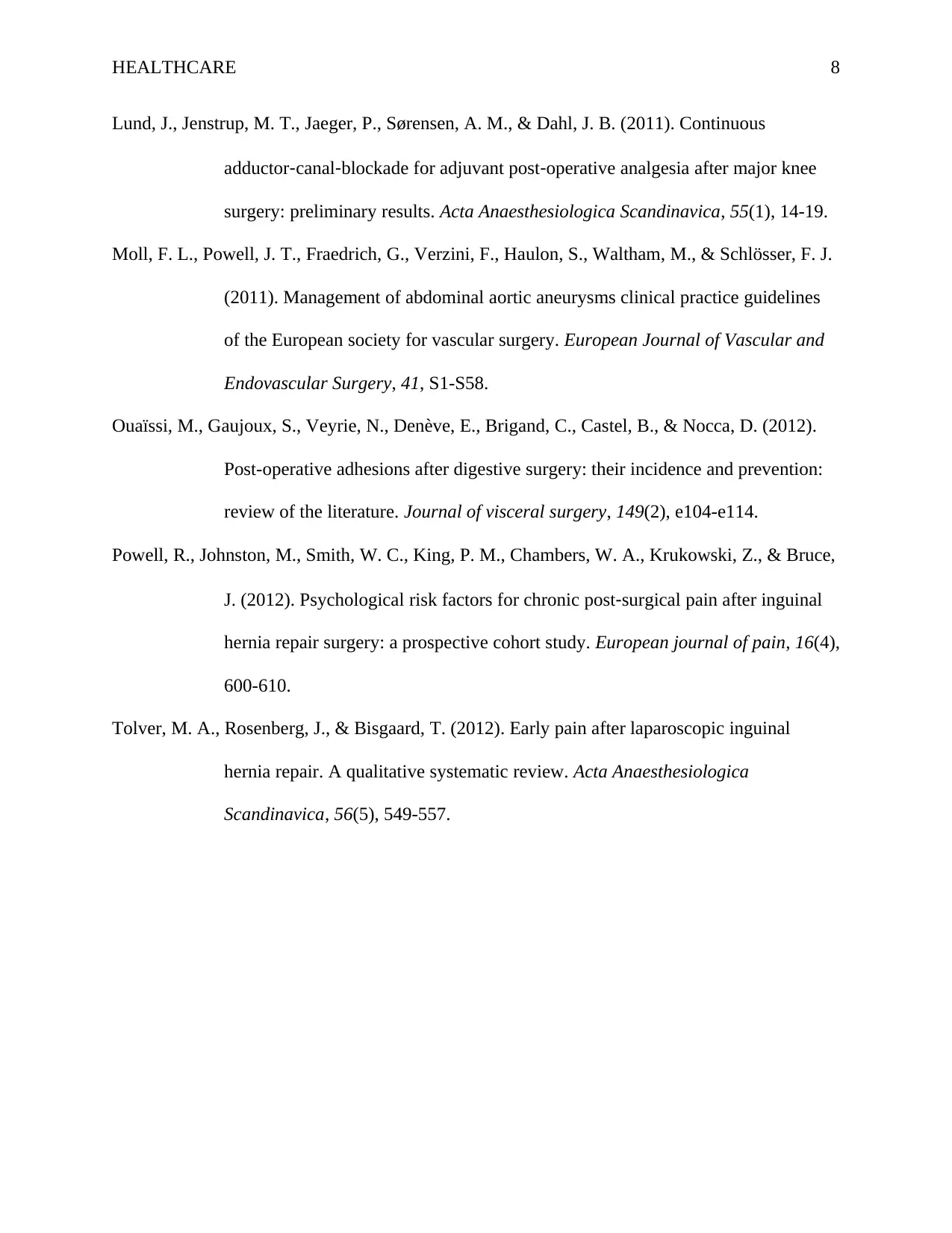
HEALTHCARE 8
Lund, J., Jenstrup, M. T., Jaeger, P., Sørensen, A. M., & Dahl, J. B. (2011). Continuous
adductor‐canal‐blockade for adjuvant post‐operative analgesia after major knee
surgery: preliminary results. Acta Anaesthesiologica Scandinavica, 55(1), 14-19.
Moll, F. L., Powell, J. T., Fraedrich, G., Verzini, F., Haulon, S., Waltham, M., & Schlösser, F. J.
(2011). Management of abdominal aortic aneurysms clinical practice guidelines
of the European society for vascular surgery. European Journal of Vascular and
Endovascular Surgery, 41, S1-S58.
Ouaïssi, M., Gaujoux, S., Veyrie, N., Denève, E., Brigand, C., Castel, B., & Nocca, D. (2012).
Post-operative adhesions after digestive surgery: their incidence and prevention:
review of the literature. Journal of visceral surgery, 149(2), e104-e114.
Powell, R., Johnston, M., Smith, W. C., King, P. M., Chambers, W. A., Krukowski, Z., & Bruce,
J. (2012). Psychological risk factors for chronic post‐surgical pain after inguinal
hernia repair surgery: a prospective cohort study. European journal of pain, 16(4),
600-610.
Tolver, M. A., Rosenberg, J., & Bisgaard, T. (2012). Early pain after laparoscopic inguinal
hernia repair. A qualitative systematic review. Acta Anaesthesiologica
Scandinavica, 56(5), 549-557.
Lund, J., Jenstrup, M. T., Jaeger, P., Sørensen, A. M., & Dahl, J. B. (2011). Continuous
adductor‐canal‐blockade for adjuvant post‐operative analgesia after major knee
surgery: preliminary results. Acta Anaesthesiologica Scandinavica, 55(1), 14-19.
Moll, F. L., Powell, J. T., Fraedrich, G., Verzini, F., Haulon, S., Waltham, M., & Schlösser, F. J.
(2011). Management of abdominal aortic aneurysms clinical practice guidelines
of the European society for vascular surgery. European Journal of Vascular and
Endovascular Surgery, 41, S1-S58.
Ouaïssi, M., Gaujoux, S., Veyrie, N., Denève, E., Brigand, C., Castel, B., & Nocca, D. (2012).
Post-operative adhesions after digestive surgery: their incidence and prevention:
review of the literature. Journal of visceral surgery, 149(2), e104-e114.
Powell, R., Johnston, M., Smith, W. C., King, P. M., Chambers, W. A., Krukowski, Z., & Bruce,
J. (2012). Psychological risk factors for chronic post‐surgical pain after inguinal
hernia repair surgery: a prospective cohort study. European journal of pain, 16(4),
600-610.
Tolver, M. A., Rosenberg, J., & Bisgaard, T. (2012). Early pain after laparoscopic inguinal
hernia repair. A qualitative systematic review. Acta Anaesthesiologica
Scandinavica, 56(5), 549-557.
1 out of 8
Your All-in-One AI-Powered Toolkit for Academic Success.
+13062052269
info@desklib.com
Available 24*7 on WhatsApp / Email
![[object Object]](/_next/static/media/star-bottom.7253800d.svg)
Unlock your academic potential
© 2024 | Zucol Services PVT LTD | All rights reserved.


